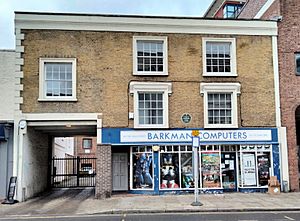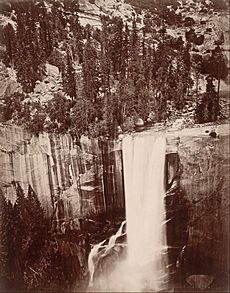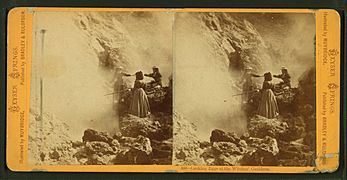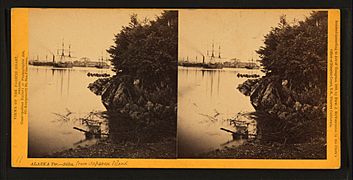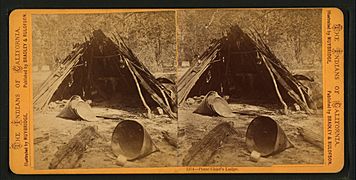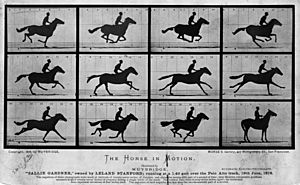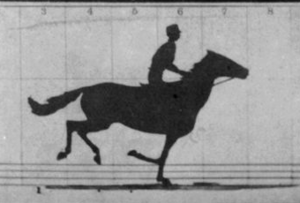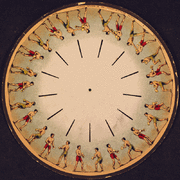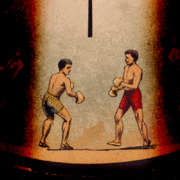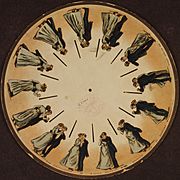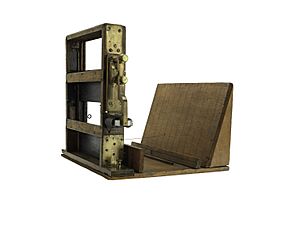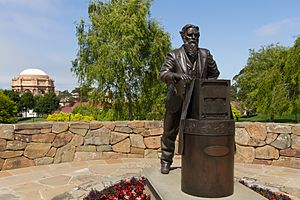Eadweard Muybridge facts for kids
Quick facts for kids
Eadweard Muybridge
|
|
|---|---|
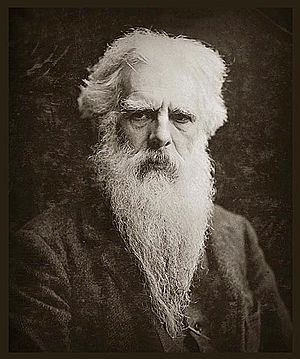
Muybridge in 1899
|
|
| Born |
Edward James Muggeridge
9 April 1830 Kingston upon Thames, Surrey, England
|
| Died | 8 May 1904 (aged 74) Kingston upon Thames, Surrey, England
|
| Resting place | Woking, Surrey, England |
| Known for | Photography |
|
Notable work
|
The Horse in Motion |
| Patron(s) | Leland Stanford |
Eadweard Muybridge (born Edward James Muggeridge; 9 April 1830 – 8 May 1904) was an English photographer. He is famous for his early work in studying motion with cameras. He also helped create early motion-picture projectors. He changed his first name to "Eadweard" because it was an older, Anglo-Saxon way of spelling "Edward." He also changed his last name to "Muybridge."
Muybridge was born in Kingston upon Thames, England. When he was 20, he moved to the United States to work as a bookseller. He lived first in New York City and then in San Francisco. In 1860, he planned to go back to Europe. On his way, he was in a serious stagecoach accident in Texas. He hit his head badly.
He spent the next few years recovering in England. During this time, he started professional photography. He learned a special way of developing photos called the wet-plate collodion process. He also got patents for some of his inventions. He returned to San Francisco in 1867. Friends noticed his personality had changed a lot after the accident. In 1868, he showed large photos of Yosemite Valley. He also sold popular stereographs of his work.
In 1875, he traveled for over a year in Central America. He went there on a photography trip.
Today, Muybridge is best known for his amazing work with chronophotography. This is a way of taking many photos quickly to show motion. He studied animal locomotion (how animals move) between 1878 and 1886. He used many cameras to capture different parts of a movement. He also invented the zoopraxiscope. This device projected painted moving pictures from glass discs. It was an early step towards modern movies.
From 1883 to 1886, he worked at the University of Pennsylvania in Philadelphia. This was a very busy time for him. He took over 100,000 pictures of animals and people moving. Sometimes, he captured moments that the human eye could not see separately.
In his later years, Muybridge gave many talks and showed his photos. He also showed his early moving pictures. He traveled often in England and Europe to share his work. He published books of his photos, which are still available today. His work greatly influenced artists and scientific photography. He moved back to England for good in 1894. In 1904, the year he died, the Kingston Museum opened in his hometown. It has a large collection of his work.
Contents
- Muybridge's Changing Names
- Early Life and Family (1830–1850)
- Becoming a Bookseller in America (1850–1860)
- Accident and Recovery (1860–1866)
- Helios: Photographer of the American West (1867–1873)
- Capturing Horse Motion (1872–1879)
- San Francisco Panorama (1878)
- Personal Life and Family (1871–1881)
- Motion Studies in Philadelphia (1882–1893)
- Later Years and Death (1894–1904)
- Muybridge's Influence on Others
- Exhibitions and Collections
- Legacy and Media Portrayals
- Images for kids
- See Also
Muybridge's Changing Names
Edward James Muggeridge was born and grew up in England. He changed his name several times. At first, he used "Muggridge." From 1855 to 1865, he mostly used the last name "Muygridge."
After 1865, he started using "Muybridge."
He also used the nickname Helios for his early photography. Helios was the Greek god of the sun. He named his studio "Helios" and gave it as a middle name to his only son, Florado Helios Muybridge, born in 1874.
In 1875, he traveled to Central America for photography. In Guatemala, he advertised his work as "Eduardo Santiago Muybridge."
After a trip to England in 1882, he changed the spelling of his first name to "Eadweard." This was an old English spelling of his name. He likely got the idea from the name of King Edward. This name was on a stone in his hometown, near his childhood home. He used "Eadweard Muybridge" for the rest of his life.
People often misspelled his last name as "Maybridge" or "Moybridge." His gravestone even says "Eadweard Maybridge."
Early Life and Family (1830–1850)
Edward James Muggeridge was born on 9 April 1830. He was born in Kingston upon Thames, England. His parents were John and Susanna Muggeridge. He had three brothers. His father sold grain and coal from the ground floor of their house. The family lived in the rooms above. After his father died in 1843, his mother continued the business.
His younger cousins, Norman Selfe and Maybanke Anderson, also spent time in Kingston. Norman became a famous engineer in Australia. Maybanke became known for fighting for women's rights.
Edward's grandfather, John Muggeridge, was a stationer. He taught Edward about the business. Many of his uncles and cousins were corn merchants. Edward's younger brother George lived with their uncle Samuel after their father died.
Becoming a Bookseller in America (1850–1860)
When he was 20, Muybridge decided to seek his fortune. He moved to the United States in 1850. He arrived in New York City. He imported and sold books from the UK. He also learned about early photography from a friend, Silas T. Selleck.
Muybridge arrived in New Orleans in January 1855. He was listed as a book agent there.
He likely arrived in California around autumn 1855. He visited Sacramento in 1856. Soon after, he settled in San Francisco. He sold books and art in this busy "Wild West" city. San Francisco was still a booming "capital of the Gold Rush." He worked with W.H. Oakes as an engraver and publisher. He also continued to be a book agent.
In 1858, Muybridge moved his store. His friend Silas Selleck had a photo gallery nearby. Muybridge was a member of the Mechanic's Institute. In 1859, he became a director for the San Francisco Mercantile Library Association.
Muybridge sold landscape photos by Carleton Watkins. He also sold copies of paintings. It's not clear if he took photos himself before 1860. However, he later said he had been involved in photography since 1860.
Edward's brother George came to San Francisco in 1858 but died soon after. His youngest brother Thomas arrived in 1859. Edward decided to stop his bookstore business. On 15 May 1860, he announced he had sold his business to Thomas. He planned to travel to New York and Europe. He left on a stagecoach on 2 July.
Accident and Recovery (1860–1866)
In July 1860, Muybridge was in a bad stagecoach crash in Texas. He was thrown from the coach and hit his head. He woke up in a hospital with no memory of the nine days after the accident. He had headaches, double vision, and problems with hearing, taste, and smell. It was said his hair turned from brown to grey in three days. These problems lasted for months.
Some experts think Muybridge's brain injury affected his personality. It may have made him more eccentric. This kind of injury is still hard to treat today.
Muybridge was treated in Texas and then in New York City. He sued the stagecoach company and won $2,500. He then traveled to England for more medical care. A doctor named Sir William Gull suggested he rest and spend time outdoors. Gull also suggested he change his job.
Muybridge stayed with family in England. He later said he became a photographer because Gull suggested it. However, photography involved heavy equipment and darkroom chemicals. This didn't quite fit the idea of rest.
In 1860, Muybridge applied for a British patent for "An improved method of, and apparatus for, plate printing." In 1861, he received another patent for "Improvements in machinery or apparatus for washing clothes." His inventions were shown at the 1862 International Exhibition.
Muybridge's activities between 1862 and 1865 are not well known. He was in Paris in 1862 and 1864. In 1865, he was a director for some short-lived companies.
He may have started photography between 1861 and 1866. He might have learned the wet-plate collodion process in England. He may have been influenced by famous English photographers like Julia Margaret Cameron.
Helios: Photographer of the American West (1867–1873)
Muybridge returned to San Francisco on 13 February 1867. He was a changed man. Friends said he became an eccentric artist. He was less careful about his looks and easily upset. He cared more about beauty than money. He would refuse payment if a customer criticized his work. His friend Silas Selleck said he barely recognized Muybridge.
Muybridge turned a horse carriage into a portable darkroom. He called it "Helios' Flying Studio." He became very good at photography. He focused on landscapes and buildings. An advertisement from 1868 said he would photograph homes, ranches, mills, animals, and ships. He also copied drawings and artworks.
Muybridge always tried to improve his cameras and chemicals. In 1869, he patented a "sky shade." This helped reduce bright skies from washing out photos. He also edited his photos a lot. He added clouds, the moon, or even volcanos for artistic effect.
San Francisco Views
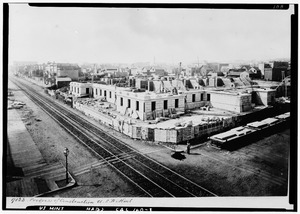
Helios made over 400 different stereograph cards. These were sold to tourists and collectors. Many showed views of San Francisco. Stereo cards were very popular at the time.
Muybridge was hired to photograph Woodward's Gardens. This was an amusement park, zoo, and museum in San Francisco.
He also took pictures of ruins after the 21 October 1868 Hayward earthquake.
During the building of the San Francisco Mint (1870–1872), Muybridge took many photos. He documented the building's progress over time. This was like early time-lapse photography. These photos may have caught the eye of Leland Stanford. Stanford later hired Muybridge for his famous motion studies.
Yosemite
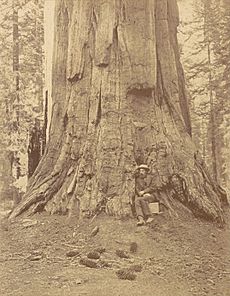
From June to November 1867, Muybridge visited Yosemite Valley. He took big risks to get his photos. He used a heavy camera and glass plates. A photo from 1872 shows him sitting on a rock over Yosemite Valley. There was 2,000 feet of empty space below him. He returned with many photos. He chose 20 pictures to be edited for a special series. These photos were also used in a guide book called Yosemite: Its Wonders and Its Beauties (1868).
Some of his pictures were of the same places photographed by Carleton Watkins. Muybridge's photos showed the grand scale of the West. If people were in the pictures, they looked tiny. Watkins' photos were calm and stately. Muybridge's were more dramatic and unsettling. Some people now claim that many of Muybridge's landscape photos were actually taken by Watkins. However, this is still debated. Muybridge soon began to create his own new ways of capturing fast motion.
Government Photography Missions
In 1868, the US government hired Muybridge. He traveled to Alaska to photograph the Tlingit Native Americans and the landscapes.
In 1871, the United States Lighthouse Board hired him. He photographed lighthouses along the American West Coast. He traveled on a ship called the Shubrick.
In 1873, the US Army hired Muybridge. He photographed the "Modoc War" in California and Oregon. Many of these photos were carefully set up. This was because the cameras needed long exposure times.
- Commercial stereograph photos by Muybridge
-
Fort Tongass, Group of Indians (1868)
-
South Farallon Island, Sea Lions in Main Top Bay (c. 1867–1872)
-
Paiute Chief's Lodge (c. 1870)
-
A Modoc Warrior on the War Path (1873)
Capturing Horse Motion (1872–1879)
In 1872, Leland Stanford, a former governor of California and racehorse owner, hired Muybridge. Stanford wanted photos of his mansion and his racehorse, Occident.
Stanford also wanted a clear picture of a horse at full speed. He thought that most drawings of horses running were wrong. The human eye couldn't see the fast movements of a horse's trot or gallop. Artists usually drew horses with one foot on the ground while trotting. For a gallop, they drew all four feet off the ground when the legs were stretched out. There are stories that Stanford made a big bet about how horses move. But there is no proof of this bet. He spent about $50,000 to fund Muybridge's studies.
In 1873, Muybridge used one camera to take a small, blurry picture of Occident running. Early photos were often blurry because the camera film was not very sensitive. Both Muybridge and Stanford agreed the photo wasn't great. But Stanford was excited to finally have a real picture of a running horse. This first photo has not been found.
Muybridge promised to find better ways to photograph motion. His work was delayed by personal events. With help from engineers, Muybridge experimented with faster camera shutters. He also developed electric triggers for his cameras. He used more sensitive film to allow for shorter exposure times.
In July 1877, Muybridge took a new, clearer picture of Occident. He had an artist improve the photo and published it. News of this breakthrough spread. But some critics thought the edited photo wasn't real. Muybridge let reporters see the original. But he and Stanford were planning a new project to convince everyone.
In June 1878, Muybridge took a series of photos. He used 12 cameras along the racetrack at Stanford's farm. The cameras were triggered automatically. Wires connected to an electric circuit were tripped by the horse's legs. On 15 June 1878, reporters and horse experts watched the process. An accident with a strap was captured in the photos. This convinced even the most doubtful witnesses. News of his success spread worldwide.
Newspapers reported that Muybridge showed his photos using a magic lantern on 8 July 1878. Newspapers couldn't print detailed photos back then. So, the images were printed as woodcut engravings. Scientific American published reports and engravings of Muybridge's photos. Six different series were soon published as cards called The Horse in Motion.
Many people were surprised by what they saw. They learned that a running horse sometimes has all four hooves in the air. This happens when its legs are tucked under its body, not when they are stretched out.
In 1879, Muybridge continued his studies with 24 cameras. He published a special collection of these results.
Muybridge copied his motion study images onto a disc. He made them into silhouettes or line drawings. These discs were for his new machine, the "zoopraxiscope." Later, he hand-colored more detailed images and sold them. His device was seen as an early movie projector. His process was a step towards modern movies.
San Francisco Panorama (1878)
In 1878, Muybridge created a famous 13-part 360° photo panorama of San Francisco. He gave a copy to Leland Stanford's wife. Today, you can see it online as a seamless panorama.
That same year, he applied for a patent for a camera shutter. It was for photographing moving objects with a mechanical trigger. Later, he applied for another patent using an electrical trigger. He also filed for British and French patents.
Personal Life and Family (1871–1881)
On 20 May 1871, Muybridge, then 41, married Flora Shallcross Stone, who was 21. They had different tastes because of their age difference. Muybridge often left home for days or weeks for his projects. This continued after his marriage.
On 14 April 1874, Flora gave birth to their son, Florado Helios Muybridge.
Flora became involved with a friend named Harry Larkyns. Muybridge found out about their relationship. He also saw a picture of his son with "Harry" written on the back. This made him think Larkyns was the father.
On 17 October 1874, Muybridge found Larkyns and shot him. Larkyns died that night. Muybridge was arrested.
Flora filed for divorce. Muybridge was tried for murder in February 1875. He was found not guilty by the jury.
This event stopped his photography studies for a while. But his relationship with Stanford continued. By 1877, Muybridge was back to working for Stanford.
After his trial, Muybridge left the United States. He went on a 9-month photography trip to Central America. His photos from this time are less known. He may have improved his fast photography skills during this trip. This was because he had to take pictures on a constantly moving ship.
Flora's second request for divorce was granted in April 1875. Flora died suddenly in July 1875. She had placed their son, Florado, with a French couple. In 1876, Muybridge moved the boy to a different orphanage and paid for his care. He did not have much to do with him otherwise.
Photos of Florado as an adult show he looked a lot like Muybridge. Florado worked as a ranch hand and gardener. He died in 1944 after being hit by a car.
Muybridge's court case is important to historians today. It provides details about his state of mind and behavior.
In 1982, composer Philip Glass created an opera called The Photographer. It was based on the court records from Muybridge's trial.
Motion Studies in Philadelphia (1882–1893)
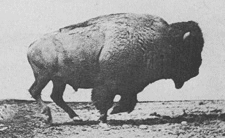
Muybridge often traveled to cities in America and Europe. He wanted to show his work. Travel was much faster by train and steamship. On 13 March 1882, he gave a lecture in London. The audience included members of the Royal Family. He showed his photos and moving pictures using his zoopraxiscope. He also lectured at other important art and science groups.
Muybridge and Stanford had a disagreement. Stanford had asked his friend, Dr. J.B.D. Stillman, to write a book about The Horse in Motion. The book was published in 1882. Stillman used Muybridge's photos and research. But he did not give Muybridge much credit. A historian suggested Stanford saw Muybridge as just an employee.
Because Muybridge wasn't credited, a group called the Royal Society of Arts stopped funding his studies. They also refused to publish his paper. Muybridge sued Stanford but the case was dismissed. Stillman's book did not sell well. Muybridge found funding elsewhere. The Royal Society of Arts later invited him back to show his work.
In 1883, Muybridge gave a lecture in Philadelphia. Artists and university leaders invited him to work at the University of Pennsylvania (Penn). Between 1883 and 1886, Muybridge took over 100,000 photos. He worked in a special studio at Penn. He could now afford many high-quality lenses. This allowed him to take clearer pictures from different angles at the same time.
In 1884, artist Thomas Eakins worked with Muybridge. Eakins wanted to learn about using photography to study motion. Eakins later preferred taking many photos on one negative. Muybridge continued to use many cameras for separate images. These could be projected by his zoopraxiscope.
Most of Muybridge's work was done outdoors in a sunlit studio. This was because cameras were bulky and film was slow. He took photos in the summers. Winters were spent developing and organizing the images. He used 12 custom-made cameras. He photographed professors, athletes, students, and patients. He also borrowed animals from the Philadelphia Zoo.
The people he photographed moved in many ways. They walked up stairs, hammered, carried water, or threw water. Muybridge photographed farm work, factory work, and everyday activities. He also photographed sports like baseball and boxing. He even posed for some photos himself, like one showing him swinging a miner's pick. He spent a lot of time preparing his photos for publication.
In 1887, his photos were published in 11 large books. The collection was called Animal Locomotion: an Electro-photographic Investigation of Consecutive Phases of Animal Movements. It had 781 plates and 20,000 photos. Muybridge's work greatly helped the study of how bodies move. Some of his books are still used today by artists and animators.
In 1888, the University of Pennsylvania gave some of Muybridge's photos to the sultan of the Ottoman Empire. The sultan was interested in photography. This gift may have helped the university get permission for archaeological digs in Mesopotamia (now Iraq). The sultan later sent his own photo albums to the United States.
Muybridge was influenced by and influenced French photographer Étienne-Jules Marey. In 1881, Muybridge visited Marey's studio in France. Marey was a pioneer in taking multiple photos on one image.
Marey's work was very scientific. Muybridge's work was sometimes more artistic. Muybridge admitted that he sometimes replaced failed photos with others. He did this to show a typical movement, not always a strict scientific record.
Today, similar camera setups are used in special effects photography. This is often called "bullet time" photography. It captures changing camera angles with little subject movement.
After his work at the University of Pennsylvania, Muybridge traveled widely. He gave many lectures and showed his photos and early moving pictures. At the Chicago World's Columbian Exposition in 1893, Muybridge gave talks. He used his zoopraxiscope to show his moving pictures to people who paid to see them. This was the first commercial movie theater. He also sold souvenir discs that showed simple animations.
- Phenakistoscope discs published by Muybridge (1893)
-
A Couple Waltzing
Later Years and Death (1894–1904)
Eadweard Muybridge returned to England in 1894. He continued to give many lectures. He came back to the US once more in 1896–1897. He settled his financial matters and property related to his work at the University of Pennsylvania. He kept control of his photo negatives. He used them to publish two popular books: Animals in Motion (1899) and The Human Figure in Motion (1901). Both books are still printed today.
Muybridge died on 8 May 1904 in Kingston upon Thames. He died from prostate cancer at his cousin's home. It is said that he was digging a scale model of the American Great Lakes in his garden at the time. His body was cremated. His ashes were buried in Woking, Surrey. His gravestone misspells his name as "Eadweard Maybridge."
In 2004, a plaque was put on the outside wall of his cousin's house. Many of his papers and items were given to Kingston Library. They are now owned by Kingston Museum in his hometown.
Muybridge's Influence on Others
In 2010, painter Philip Pearlstein wrote about Muybridge's influence. He said Muybridge's work affected many 20th-century artists. These included Degas, Rodin, Seurat, and Eakins. This influence came directly or through Marey's work. Pearlstein believed Muybridge should be seen as one of the most important artists for 20th-century art ideas.
Exhibitions and Collections
Muybridge left some of his equipment to Kingston Museum in London. This includes his original slide projector, a zoopraxiscope, over 2,000 glass slides, and 67 zoopraxiscope discs. The University of Pennsylvania Archives has a large collection of Muybridge's photos, equipment, and letters. This includes 740 of the original glass plate negatives from his main work.
The Philadelphia Museum of Art also has a large collection of Muybridge's materials. This includes hundreds of prints, negatives, and camera equipment. The Stanford University Libraries also have many of Muybridge's photos, negatives, and some equipment. This includes a working zoopraxiscope.
In 1991, the Addison Gallery of American Art held a big exhibition of Muybridge's work. It also showed works by artists he influenced. The show traveled to other places. The Addison Gallery has many of Muybridge's photos.
In 1993, the Canadian Centre for Architecture showed an exhibition. It was called Eadweard Muybridge and the Photographic Panorama of San Francisco, 1850-1880.
From 2000–2001, the Smithsonian Institution had an exhibition. It was called Freeze Frame: Eadweard Muybridge's Photography of Motion. It also had an online version.
From 10 April to 18 July 2010, the Corcoran Gallery of Art had a major show. It was called Helios: Eadweard Muybridge in a Time of Change. The exhibition received good reviews. It later traveled to Tate Britain in London and the San Francisco Museum of Modern Art.
An exhibition of items Muybridge left to Kingston upon Thames opened in 2010. It was called Muybridge Revolutions. It ran until 2011. The full collection is held by the Kingston Museum and Archives.
Legacy and Media Portrayals
Muybridge's work influenced many people. These included efficiency expert Frank Gilbreth and Walt Disney.
- A building at Kingston University is named after Muybridge.
- Many of Muybridge's photo sequences are used as reference books for artists. Cartoon animators often use his photos to draw characters in motion.
- In a 1964 TV show called Death Valley Days, Hedley Mattingly played Muybridge. The story was about Muybridge inventing the zoopraxiscope for Leland Stanford. He had to prove if a horse's hooves were all off the ground while trotting.
- Filmmaker Thom Andersen made a 1974 documentary. It was called Eadweard Muybridge, Zoopraxographer. It described his life and work.
- The composer Philip Glass's opera The Photographer (1982) is based on Muybridge's murder trial.
- Muybridge is a main character in John Edgar Wideman's 1987 novel Reuben.
- Since 1991, a company called Optical Toys has published Muybridge's sequences as movie flipbooks.
- The music video for U2's "Lemon" (1993) was filmed in black and white with a grid background. This was a tribute to Eadweard Muybridge.
- The play Studies in Motion: The Hauntings of Eadweard Muybridge (2006) was about Muybridge's obsession with cataloging animal motion. It started touring in 2010 and was made into a film in 2015.
- Canadian poet Rob Winger wrote Muybridge's Horse: A Poem in Three Phases (2007). It explored Muybridge's life and obsessions.
- A short documentary about Muybridge was made in 2007 by Juho Gartz. It won "Best Documentary" at a film festival.
- The BBC made a TV program about Muybridge in 2010. It was called "The Weird World of Eadweard Muybridge."
- A short animated film called Muybridge's Strings was released in 2011.
- On 9 April 2012, Google honored Muybridge with a special animated picture. It was based on his horse in motion photos.
- The 2015 film Eadweard tells the story of Muybridge's motion experiments.
- Muybridge appears as a character in Brian Catling's 2012 novel, The Vorrh.
- A Czech theater company created a play about Muybridge's life in 2014. It combined dancing, speech, and multimedia from his works.
- In 2017, five frames of a horse photographed by Muybridge were encoded into bacteria's DNA. Most of them could be recovered.
- In her book River of Shadows, Rebecca Solnit tells Muybridge's story. She explores how 19th-century California became a center for new ideas.
- Exposing Muybridge (2021) is a documentary film. It highlights Muybridge's use of image editing and "photographic truth."
- The First Film mentions Muybridge when discussing early cinema.
Images for kids
See Also
 In Spanish: Eadweard Muybridge para niños
In Spanish: Eadweard Muybridge para niños



